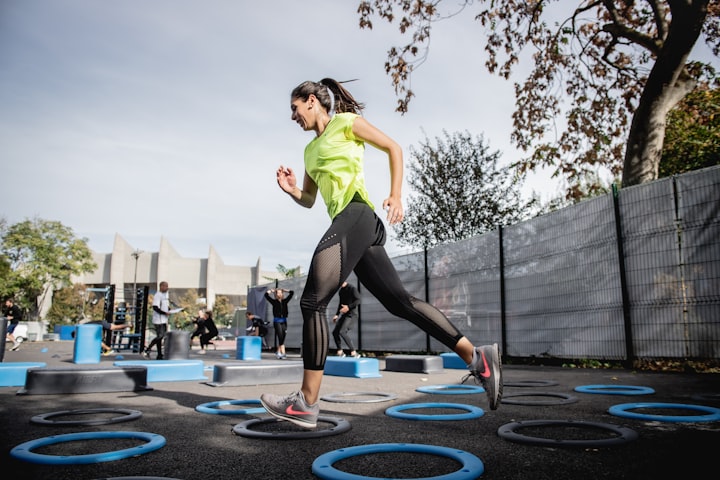You tore you ACL: What to do after you’ve been “cleared”
and how to get back to doing what you love.

This is the last installment of my ACL Series. At least for now. We’ve gone over the why and how of tearing your ACL. Today, we will address what happens after you get cleared.
If you’ve missed the first two sections, no worries. I have linked them in the article and because people are lazy, here’s the SparkNotes. The anterior cruciate ligament (ACL) is a major structure of support in your knee. It prevents your leg (shin) from shifting forward beyond your thigh. It is essential for people who play sports. Cutting, jumping, landing, and pivoting requires knee stability.
An unstable knee cannot support those activities and will probably "buckle” or “give out.” This significantly increases the damage to the knee joint and increases the risk of an even more traumatic injury if not addressed. On the positive note, people that are not athletes do not need their ACLs to enjoy a high quality of life. There are dozens of people walking around without one or both of their ACLs and some of them don’t even know it.
The real reason we get injured.
Especially if you have a previous injury or experience chronic pain. The human body is built on a principle called tensegrity. In living creatures, bio tensegrity describes the connective tissues working together with our skeleton to keep our body shape and function.
Think about all the times you rolled your ankle. It never stopped you from trying to walk it off. Some people even play through the injury. You absolutely hurt yourself and because of tensegrity, your body compensated to take the pressure off of your injured ankle.
Our bodies do it without us even thinking about it.
Unfortunately, these minor adaptations that help you function create an imbalance. Displacing stress in around the body to help you function. Remember, our bodies don’t know that we're just working out or playing a game of soccer. Maybe you’re running from danger. Compensations can occur over suboptimal movement patterns. Which may be the foundation for poor sports mechanics.
The result? A body susceptible to injury. The problem?
Even after surgery, the underlying issues still exist. Patterns of stress still engrained in the body. Which has several negative impacts on your recovery and return to activity/sports:
- Delaying/Stunting the Recovery Process: You’re starting from a subpar foundation. Lacking connection to your body and the ability to recruit enough of the muscles or even worse, using the wrong muscles.
- Improper Movement Patterns: Your mechanics are off. Running, jumping, and landing are all adding stress to your body because of it. Again, training in these positions won’t strengthen you and may actually increase the stress on your joints.
- Limited Muscle Activation: Limited muscle activation is the byproduct of improper mechanics that develop into the source of dysfunction. You’ve been doing the movement pattern (the exercise) for months but have never felt it where you were supposed to. It might even hurt.
SURPRISE! Our body can function under the worst conditions. You can even be successful at your sport, which is why your coaches ignored the signs and you ignored the symptoms. Which allowed you to push through therapy and get the designation “cleared” but you’re still in pain and don’t feel ready to return to sport.

The Solution: What to do when you’ve been cleared.
The first thing you should do when you’ve been cleared is get a movement screening. You need an assessment of your body mechanics where they are today. This will let you know if there are any issues with our foundation.
Every person should be assessed at the beginning of their activity, even if it’s just the next phase of that activity. We think about starting a new sport, but what about when you finish your workout program and begin the next one? You need to make sure that your foundation is solid.
Today, the Functional Movement Screening (FMS) is one of the most popular screening in professional sports. Many professionals in the industry offer screenings as a part of their training programs or as a service. The professional will let you know if there are issues with your body, where they are located, and the implications.
After being screened, we have some idea of the underlying issues in your body. From there, a trained professional can create a program to address the issues with your body. These fundamental issues include ankle mobility, knee stability, and hip mobility, both static and dynamic. There are many other factors observed, but again, this isn’t a tutorial on screening it is simply an introduction to the process.
The Reason You’re Still Hurting:

Understanding that your body could have been imbalanced before you were injured, there are definitely issues after injury. Mechanics that added more stress to your knees before injury are painful after injury. Think about what that means.
People are moving every day with mechanics that are stressful to the knee and don’t realize it.
Now, after the injury, you don’t have that luxury. The reason you’re hurting is that your movement patterns add stress to your knee. Thus, whenever you run or try to cut, your knee is letting you know it’s not right. Of course, before injury we would just muscle through it now the pain is too great and the fear of another injury has made you more cautious.
In therapy, or with a trainer, you went over positioning and mechanics. This is where a movement specialist comes in handy. You wouldn’t believe how many people I run into struggled to activate the right muscles let alone use them.
We hear about the “quad dominant” athletes. That also means that your hamstrings and hips may be inactive and eventually they stop firing. Long story short, your body is efficient (lazy) and those muscles cost way too much energy support if you're not to be using them.
I created a system of evaluation specifically for muscle activation assessment during training. It’s really simple and a marker of a high-quality return to play protocol.
For nearly a decade, I worked in an facility with sports doctors, physical therapists and occupational therapists. When an athlete needed to transition into their sports activities, I would be consulted.
First thing I look for: Does the athlete know how to run?
It seems like a ridiculous question, but honestly, you probably don’t know how to run correctly. Most pros don’t even have to look at you to know you’re not running correctly. We can hear it. Anyone who has been through therapy knows that eventually you’ll be asked to run on the treadmill. That’s usually when I get involved with an athlete returning to play.
Why You Struggle to Return to Sport.

Considering you’ve gone through all the steps. Got screened and firing your muscles correctly isn’t a problem for you. However, you still have pain and discomfort with sport. Why?
You aren’t in shape for sports and skills have regressed.
We’ve established you can finish therapy without using the right movement patterns or using the right muscles. In your mind, you believe you're moving the same as before. No. You’re not, but you can't feel the difference.
Obviously, your sports skills will also suffer after an injury. If you can’t feel the difference in how you walk or run, why would you believe you’d be aware of how you shoot, swing, throw, tackle, or kick? Those patterns have changed and must be relearned. Even regressing the skill if necessary.
Conditioning is often overlooked as well.
We need to know when the athlete is returning to activity. What part of the season are they in? You are not prepared for sports if you are not in the physical condition to take part in sports. That’s a risk factor for injury impacting all athletes. Making it much more dangerous to athletes returning from injury.
Even if you have the right activation and ideal mechanics, it all goes out the window when you get tired. Muscle fatigue and sloppy mechanics. If an athlete has not been conditioned to match the conditioning level of their sports season, they will feel it. Powering through will just reinforce suboptimal or even harmful movement patterns.
Closed Skills Don’t Transfer
Part of the secret ingredient in my return to play recipe. It seems so obvious. For those that aren’t aware, closed skills are those that occur in predictable and stable environments. Therapy is essentially closed skills only. Now, competitive sports require open skills. The environment is constantly changing and unpredictable.
The difference causes many issues for athletes returning to play.
It falls between body awareness and conditioning. Like a lack of conditioning, athletes attempt to overcome a lack of skills with physical ability and effort. Increasing the strain on the body and especially the knee. Again, if you want a full breakdown of body awareness and conditioning, message me.

Summary
Athletes can produce in sports with improper mechanics that add stress to the body. Creating a system of stress that predisposes us to injuries. Our knee is a stability joint. The ACL is a ligament that helps stabilize the knee and prevents anterior translation of the tibia on the femur. Thus, when there is too much stress on the knee joint, the ACL can tear.
The average person doesn't need their ACL. Athletes, however, need a stable knee and, in most circumstances, it will require surgery to continue your athletic career. Otherwise, you risk significant injury to the integrity of the joint.
Several risk factors are associated with increased risk of ACL injury. A cold, stiff joint, lack or perpetration/proper warm-up, issues with your motor patterns, body mechanics and/or muscle activation pre-/post- injury. Lacking the required skills and/or conditioning is one of the most overlooked risk factors for injury.
Many people struggle with injuries even after they get cleared because they never address the source of the injury.
Screening and assessments are tools we have to determine if an individual is fit for activity. From occupational to recreational. From exercises to high-level sport. People only benefit from exercise when their body functions as intended. It’s possible to finish therapy and compete even if we are unfit. Causing you to repeat stress patterns and getting hurt again.
At the end of therapy, or between therapy and sport, athletes needs to address their movement patterns, muscle activation, conditioning, and sports skills. Putting them at reduced risk for any injury. Avoiding re-injury and returning to sport with a foundation that’s better than what you had before the injury.
About the Creator
Blake A Swan
NCSA Strength and Conditioning Professional certified as a CSCS, TSAC-F, and CPT. I have my FMS Certification as well, and spent over a decade working with athletes in various sports. Including youth, high school, college, Olympic and Pro.
Enjoyed the story? Support the Creator.
Subscribe for free to receive all their stories in your feed. You could also pledge your support or give them a one-off tip, letting them know you appreciate their work.






Comments
There are no comments for this story
Be the first to respond and start the conversation.